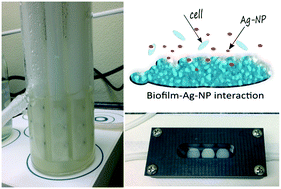Bioaccumulation of silver nanoparticles in model wastewater biofilms†
Abstract
Engineered nanoparticles are increasingly incorporated into consumer products and inevitably released into wastewater. This study explored the capacity for wastewater biofilm to accumulate and release silver nanoparticles (Ag-NPs). Synthetic wastewater (SW) was used to feed wastewater biofilm in two types of reactors: a CDC biofilm reactor (CBR) and a flow cell. Using typical wastewater bacteria (Acinetobacter calcoaceticus, Comamonas testosteroni, and Delftia acidovorans) as a model consortium, biofilm functionality, structure, and viability were monitored with and without Ag-NPs exposure in the CBR. At a design concentration of 200 ppb, no significant change in biofilm viability or functionality were observed. However, significant cell stress was detected with the generation of excess reactive oxygen species. To measure Ag-NP accumulation, the flow cell experiments were performed for each species singly, in dual combinations, and mixed at the same design concentration as previous. The single species biofilms accumulated the least amount of silver, approximately 0.01 ng mm−2. The dual species, A. calcoaceticus and D. acidovorans accumulated 0.43 ng mm−2, the highest measured concentration of these combinations. This combination was then further tested for the possible release of silver. After Ag-NP exposure, biofilm detachment and total silver concentrations in influent and effluent were measured. While effluent cell counts did not significantly change (p > 0.05), the measured silver attached to the biofilm significantly decreased (p = 0.04). This shows that small concentrations of silver attached to the biofilm and was subsequently released. Given the dynamic nature of living biofilms, this study indicates that wastewater biofilm plays a small role in silver transport in wastewater networks. Further, this work could potentially apply to the fundamental understanding of biofilm – NP interactions in other systems.



 Please wait while we load your content...
Please wait while we load your content...
